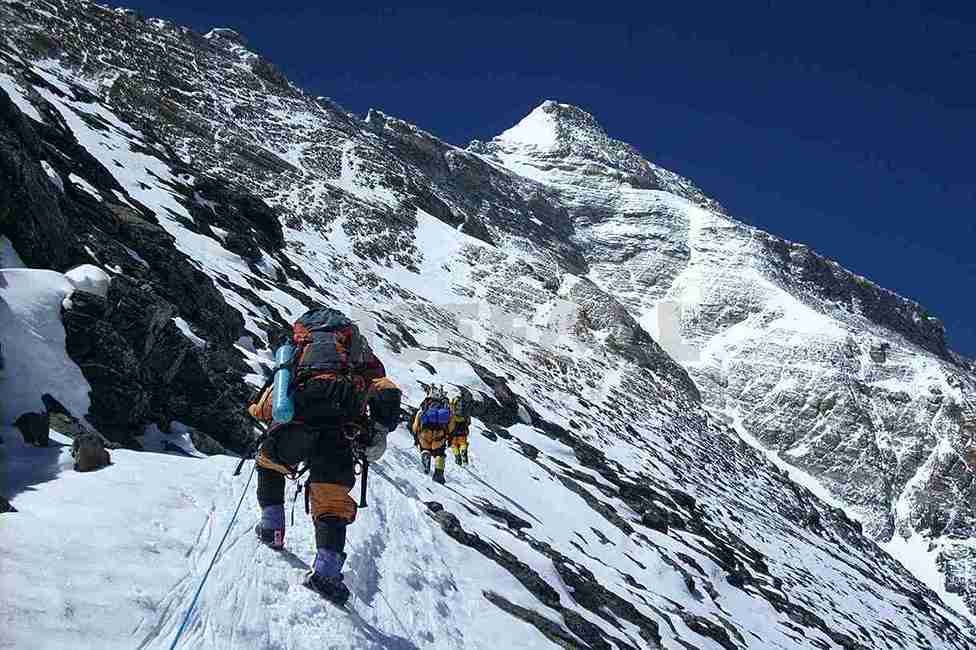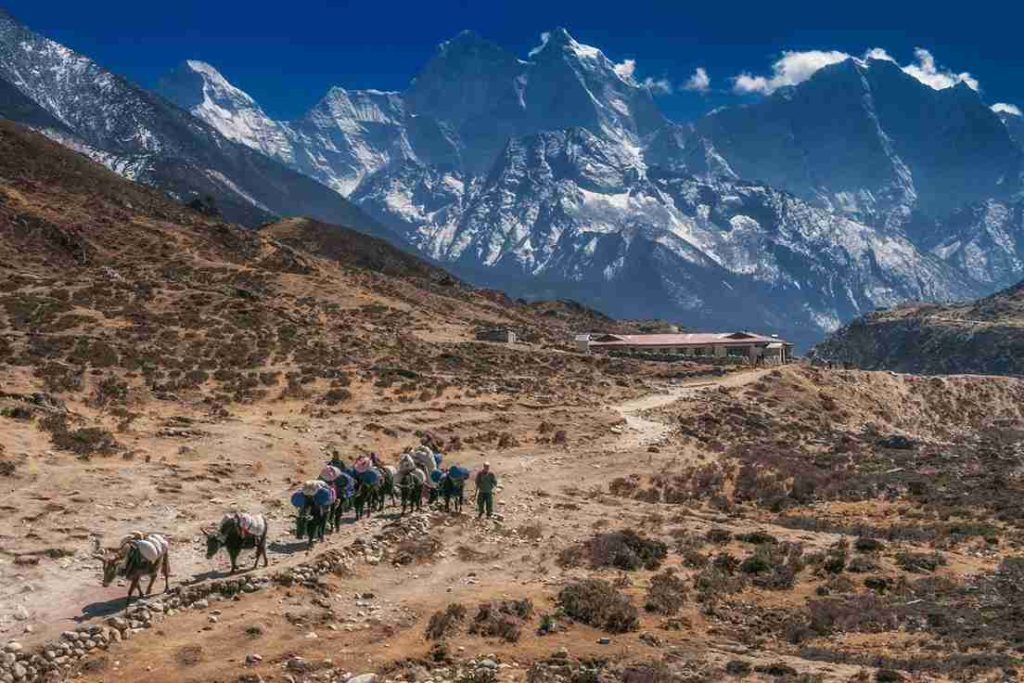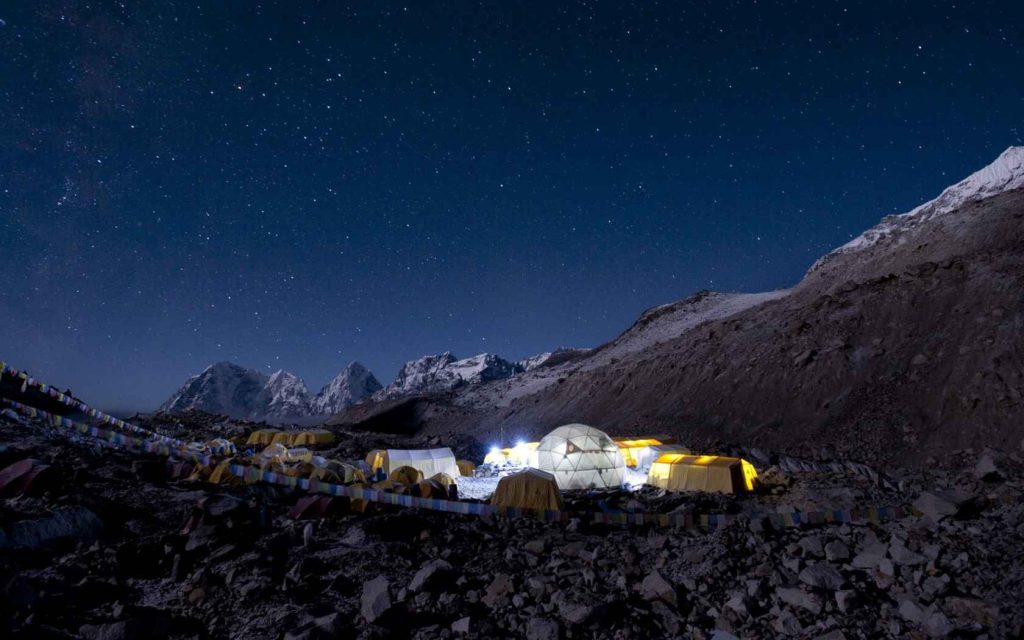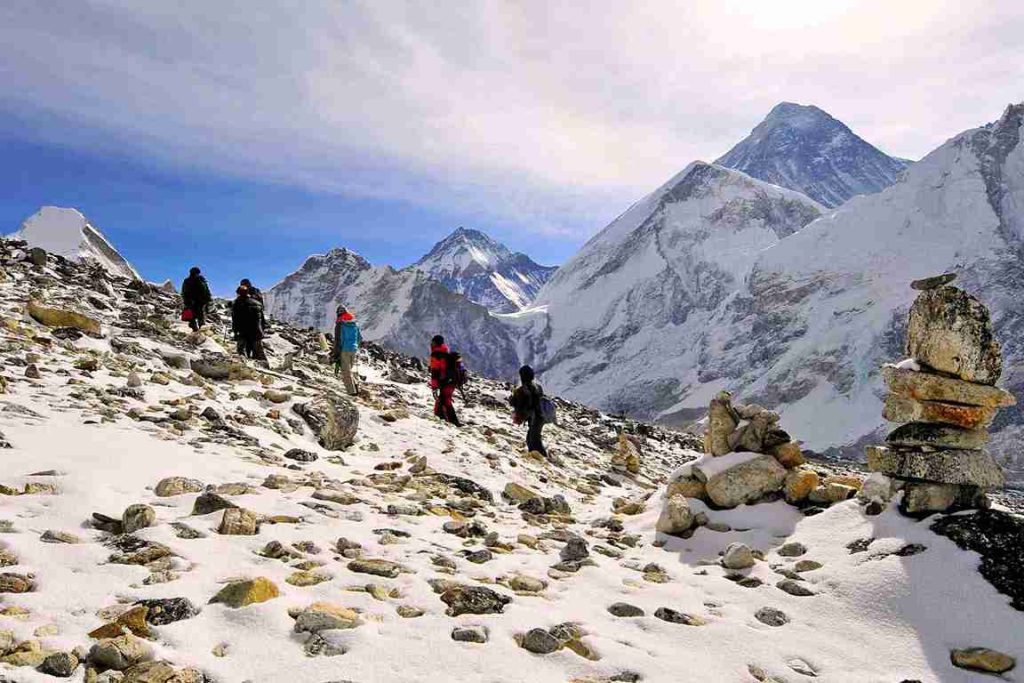Trip Facts
Duration
14 Days
Trip Grade
Difficult
Country
Nepal
Maximum Altitude
5,545 m
Group Size
2–12
Starts
Lukla
Ends
Lukla
Activities
Trekking
Best Time
Mar to May, Sept to Nov
Highlights
- Get to the famous Everest Base Camp (5,364m) and stand in the shadow of the tallest mountain in the world.
- If you hike to Kala Patthar (5,545m), you’ll see Mt. Everest at sunrise that will blow your mind.
- Sagarmatha National Park is a UNESCO World Heritage Site with beautiful views of the Himalayas.
- Experience the warm Sherpa hospitality in traditional mountain villages like Namche Bazaar, Tengboche, and Dingboche
- Explore Tengboche Monastery, the spiritual heart of the Khumbu region
- Scenic mountain flight between Kathmandu and Lukla
- Two acclimatization days built in for a safe and enjoyable trek
- Stay in cozy teahouses with hot meals and friendly hosts every night
Overview
This 14-day package brings you straight to the heart of the Himalayas for the famous Everest Base Camp Trekking. The walk starts with an exciting flight to Lukla and then follows old mountain paths through alpine forests, deep river valleys, and traditional Sherpa communities. You’ll gradually gain altitude as you pass through places like Namche Bazaar, Tengboche, and Dingboche—each offering their own charm and views. Two important acclimatization days ensure your body adjusts to the elevation, so you can safely reach Everest Base Camp and then climb up to Kala Patthar for the best views of Everest itself.
This journey is not just about reaching base camp—it’s about the culture, the people, the peace, and the power of the Himalayas. Our professional guides, carefully planned itinerary, and commitment to responsible trekking will give you the safest, most memorable experience possible. Whether it’s your first high-altitude trek or a bucket-list dream, this is your chance to be part of Everest’s legacy.
Itinerary
When you get to Tribhuvan International Airport in Kathmandu, our representative will meet you and take you to your hotel in Thamel, the city's most famous tourist area. After you check in and rest, there will be a pre-trek briefing in the evening with your trekking guide. During this session, we’ll go over the trek plan, check your gear, and answer any questions. You’ll also enjoy a welcome dinner featuring authentic Nepali cuisine. Overnight at hotel.
Our trip starts with a beautiful early morning flight to Lukla, which is the route to get to the Everest region. The flight lasts 30 minutes and gives you stunning views of the Himalayan peaks. It culminates with a dramatic landing at the famous Lukla airport. After meeting the porters and getting everything ready, we start our walk by going down through woods of pine and rhododendrons. The trek goes along the Dudh Koshi River and crosses a few hanging suspension bridges. We get at Phakding village, which is on the riverbed, after a short, easy hike. Stay the night in the teahouse. Dinner is included.
After breakfast, we continue along the trail, passing through small villages like Benkar and Monjo. Just after Monjo, we enter Sagarmatha National Park, where permits are checked. Then we descend to the river, cross a high suspension bridge, and begin a steep ascent through forests. The climb is challenging but rewarding as we reach Namche Bazaar, the largest Sherpa town in the Khumbu region. On clear days, you may catch your first view of Mount Everest. Namche is well-equipped with cafes, bakeries, gear shops, and even ATMs. Overnight at teahouse.
To help your body adjust to the altitude, we spend an extra day in Namche. This isn’t a rest day in the traditional sense but a chance to hike higher and sleep low. We hike up to the Everest View Hotel (3,880m) for panoramic views of Everest, Lhotse, and Ama Dablam. Along the way, we visit the Sherpa Culture Museum and Khumjung village, home to a school built by Sir Edmund Hillary. After returning to Namche, you have the rest of the day to relax, explore the town, or grab a coffee at a local bakery.
We leave Namche on a relatively flat trail with stunning mountain views. The path gradually descends to the Dudh Koshi River, which we cross before making a steep climb through pine and rhododendron forest to reach the spiritual heart of the region—Tengboche. This village is home to the famous Tengboche Monastery, where trekkers and climbers receive blessings before heading toward Everest. The views from here are extraordinary, especially of Ama Dablam. In the evening, you may attend the monastery's prayer session.
We descend through beautiful forests, cross the Imja Khola river, and climb uphill past the villages of Debuche and Pangboche. As we gain altitude, the landscape changes—trees begin to fade and give way to shrubs and alpine meadows. The trail opens up to views of the surrounding peaks and glacial rivers. After a gradual uphill walk along stone walls and fields, we reach Dingboche, a windy settlement surrounded by towering mountains
Another important acclimatization day is spent in Dingboche. To aid the process, we hike to Nagarjun Hill (around 5,100m), a viewpoint above the village offering breathtaking views of Makalu, Lhotse, Ama Dablam, and Island Peak. The uphill hike is slow and steady, giving you time to practice walking at higher altitudes. After returning, you can explore Dingboche, take photos, or simply relax with a book in the warm dining hall.
Today’s trail climbs gradually through alpine terrain. We pass the settlement of Dughla and reach Thukla Pass, where emotional stone memorials honor climbers who lost their lives on Everest. The terrain becomes more rugged as we ascend along glacial moraines beside the Khumbu Glacier. After one final push, we arrive in the small village of Lobuche. It’s often cold and windy here, but the surrounding views of snow-covered peaks are unforgettable
This is the day you’ve been waiting for. We start early and trek to Gorak Shep, the last settlement before Everest Base Camp. After a short break, we leave our bags and hike to Everest Base Camp following the rugged glacier trail. Upon arrival, you’ll stand at the foot of the tallest mountain on earth, surrounded by icefalls, glaciers, and prayer flags. After enjoying this once-in-a-lifetime moment and taking photos, we return to Gorak Shep for the night.
We wake up before sunrise and hike to Kala Patthar, the best viewpoint in the Everest region. From the summit, you’ll witness the glowing golden sunrise over Mount Everest, Nuptse, and Pumori. This is the highest point of your trek. After this breathtaking experience, we descend to Gorak Shep for breakfast and continue our downhill journey to Pheriche, a windy valley with several lodges and an aid post.
The return journey continues as we descend through familiar landscapes, passing Pangboche and Tengboche villages again. The walk is easier with each step, and the air feels richer in oxygen. After reaching Namche Bazaar, you’ll have a chance to enjoy a hot shower and celebrate your successful trek.
Our final day of trekking follows the Dudh Koshi River back through Monjo and Phakding to Lukla. The trail is mostly downhill, and by now, you’ll notice how much stronger you feel. Once in Lukla, it's time to celebrate with your guide and porter.
We take an early flight from Lukla to Kathmandu. When you get there, our team will pick you up and take you to your hotel. You can rest, shop for souvenirs, or see the city for the rest of the day. We'll have a farewell supper in the evening to honor your trip. Stay the night at a hotel in Kathmandu.
We'll take you to the airport for your international flight after breakfast. It’s time to say goodbye to Nepal, but the memories of Everest Base Camp will stay with you forever.
Cost Details
Included
- Airport pick-up and drop-off in a private vehicle
- Domestic flights (Kathmandu–Lukla–Kathmandu)
- 2 nights’ hotel in Kathmandu with breakfast
- All teahouse accommodations during the trek
- Three meals a day on the trek (breakfast, lunch, dinner)
- Licensed English-speaking guide and porter
- Sagarmatha National Park entry fee and TIMS card
- First aid kit and pulse oximeter
- Government taxes and office service charges
Excluded
- International airfare
- Nepal visa fee on arrival
- Travel and rescue insurance
- Personal trekking gear
- Hot showers, battery charging, and Wi-Fi at teahouses
- Tips for guide and porter
- Extra meals and drinks in Kathmandu
Useful Information
- Best Time for Everest Base Camp Trekking
The best times to go trekking to Everest Base Camp are in the spring (March to May) and fall (September to November). The weather is consistent, the skies are clear, and the vistas of the mountains are at their best during these months. Spring brings blooming rhododendrons and wildflowers, while autumn offers dry trails and fresh air after the monsoon. Winter is also possible, but it will be very cold, and some teahouses may be closed. Summer (June to August) is monsoon season, with rain and clouds making trekking more difficult.Trek Difficulty and Fitness Level
Everest Base Camp Trekking is considered moderate to challenging. While no technical climbing is required, you should be able to walk 5 to 7 hours a day for over 10 consecutive days. The trek involves uphill climbs, rocky trails, and high-altitude hiking. No previous experience is necessary, but it helps to prepare in advance with walking, hiking, or cardio exercise. Mental strength, good footwear, and a slow, steady pace will make your journey easier.Altitude and Acclimatization
The maximum altitude on this trek is Kala Patthar at 5,545 meters. As we gain altitude, the amount of oxygen decreases. That’s why we include two acclimatization days (in Namche Bazaar and Dingboche) to help your body adjust gradually. Symptoms of altitude sickness include headache, dizziness, loss of appetite, and nausea. Our experienced guides carry first aid kits and monitor your health every day. If needed, we will descend immediately for your safety.Accommodation and Meals
You will stay in teahouses, which are modest mountain lodges with double rooms and shared facilities, while you are on the hike. Some charge extra for hot baths and places to charge your phone. Rice, lentils, noodles, soup, spaghetti, momos, and eggs are all healthy and nourishing foods. Eating vegetarian meals is a good way to lower your risk of becoming sick from food. You will also get three meals a day: breakfast, lunch, and dinner.Packing List
Some essentials for Everest Base Camp Trekking include:
Warm layers (base layer, fleece, down jacket)
Waterproof jacket and pants
Thermal gloves, hat, and neck buff
Sturdy trekking boots and extra socks
Sleeping bag (rated to -10°C)
Daypack with rain cover
Water bottle or hydration pack
Water purification tablets or filter
Trekking poles (optional but helpful)
Headlamp with extra batteries
Basic toiletries and personal medicines
Sunglasses and sunscreen
Passport-sized photos and insurance copyLukla Flight and Weather Conditions
Weather plays a big role on flights to and from Lukla. Bad visibility or heavy winds may cause delays and cancellations. To avoid missing international flights, we strongly suggest that you schedule at least one extra day at the end of your tour. If there are delays, you might be able to take a helicopter for an extra fee.Insurance for Travel
All trekkers must have travel insurance that covers emergency evacuation up to 6,000 meters. This is for your safety in case of altitude sickness, injury, or flight cancellation. Please bring a printed copy of your insurance and policy number.
Official Everest Base Camp Trekking (14 Days) Map

FAQs
It's not too hard, but anyone who is in decent shape can do it. We take our time with acclimatization days so you can get used to it.
No! This hike is good for beginners. To build up your stamina, just start walking a few weeks before your vacation.
Yes, but we handle it well. Our guides keep an eye on your health, and there are rest days in the program to lower the risk.
You’ll eat local meals like dal bhat, noodles, soups, and momos. It’s fresh, hot, and fills you up!
Yes, most teahouses offer both—but expect to pay extra and don’t rely on a strong signal.




